The Witcher 2: Enhanced Edition Preview
- Updated: 3rd Apr, 2012
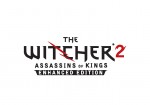 As a self-confessed PC-phobe, I haven’t been exposed to much of the hype surrounding The Witcher, mainly because I’m jealous. Lacking the funds to buy a high-end PC, or maintain one with the constant upgrades needed to run the latest games, I try to ignore all the great exclusives PC gamers get. Out of sight, out of mind right? Plus I always get dirty looks when I tell people I still use a controller when I do play PC games.
As a self-confessed PC-phobe, I haven’t been exposed to much of the hype surrounding The Witcher, mainly because I’m jealous. Lacking the funds to buy a high-end PC, or maintain one with the constant upgrades needed to run the latest games, I try to ignore all the great exclusives PC gamers get. Out of sight, out of mind right? Plus I always get dirty looks when I tell people I still use a controller when I do play PC games.
The Witcher 2 has been available on PC for almost a year now, so PC gamers already know how amazing it is. But for console gamers like me, who don’t know much about it, you’re in for one lovely RPG-sized treat. When playing this preview, the key themes that stood out for me were choice and consequence.
360 owners will be getting an “Enhanced Edition” of The Witcher 2 in just a few weeks. The “Enhanced” bit refers to the addition of a load of new content, which PC fans will get as a free update on the day of the game’s release. The game includes all previous updates and DLC, new cut-scenes, characters, locations and lots of other bits.
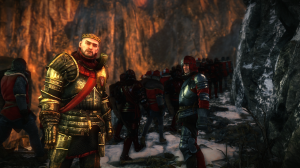 The first new thing you will notice is the fantastic cinematic introduction setting up the game’s lore. This cut-scene looks absolutely stunning, and immediately hooked me on The Witcher 2’s story. The graphical quality of these cut-scenes is impressive, but the in-game presentation is equally fantastic.
The first new thing you will notice is the fantastic cinematic introduction setting up the game’s lore. This cut-scene looks absolutely stunning, and immediately hooked me on The Witcher 2’s story. The graphical quality of these cut-scenes is impressive, but the in-game presentation is equally fantastic.
Credit must go to CD Projekt RED for being able to port the game without compromising its graphics. However it’s immediately clear that The Witcher 2 pushes the 360 to the limit. I experienced a few moments of screen-tearing during gameplay and cut-scenes, but these were infrequent and minor.
Controls
One thing that will be essential for newcomers is the new in-depth tutorial mode. The PC version had a steep learning curve that made the prologue feel like a baptism of fire. The new tutorial does great job introducing players to the world of The Witcher 2, clearly explaining how to control the game’s lead character, Geralt. While the controls are effectively explained, it’s still a lot to take in for the opening 20 minutes of a game. The tutorial only explains the all the intricacies of the game once, so you may find yourself referring to the manual from time to time.
On the 360 pad, you should expect to use every single button to effectively use everything at Geralt’s disposal. The only problem I came across was that the quick attack and action button was the same, meaning I would frequently hack away at doors and ladders a few times before interacting with them, which can be frustrating if you’re trying to flee a fight due to low health.
The prologue is told through a series of flashbacks that Geralt recounts during an interrogation, where he tries to prove his innocence. Players new to the series will miss out on some references to the game’s backstory, but these are relatively minor. The first flashback begins with Geralt in bed with a red-headed woman before being summoned by the king to fight in war over a ‘lover’s tiff’ with the queen. It was surprising to see such well written, mature and multi-layered narratives, something so rare in videogames, particularly character-driven RPGs.
Choices
As a huge RPG-fan, one thing that bugs me is the way some RPGs make dialogue choices so obvious, while their consequences are only truly felt in the game’s final hours. The inFamous and Mass Effect series are both guilty of this. Choose the blue option to be good, and the red for bad, see what it means in the final cut-scene. This isn’t the case in The Witcher 2.
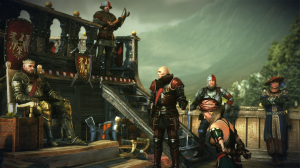 Not only are dialogue choices genuinely thought-provoking, but they have immediate consequences on everything from how people react to Geralt and what experience you have. Right away, the prologue shows the immediate consequences of your actions. Through one of my early dialogue choices, I even dictated how much of the prologue I got to see. As Geralt recounts the events from the battle, you get to choose where he starts his story from; do you want to start from when Geralt was summoned? Or skip straight to the start of the fight?
Not only are dialogue choices genuinely thought-provoking, but they have immediate consequences on everything from how people react to Geralt and what experience you have. Right away, the prologue shows the immediate consequences of your actions. Through one of my early dialogue choices, I even dictated how much of the prologue I got to see. As Geralt recounts the events from the battle, you get to choose where he starts his story from; do you want to start from when Geralt was summoned? Or skip straight to the start of the fight?
The journalist sitting next to me during this preview was progressing through the prologue at the same speed as me, and even the two of us had very different experiences. We both came to a negotiation with a prince, with the aim of making him surrender peacefully. I thought the stubborn arse of a prince would never come quietly, so felt proud when I managed to negotiate a duel with him alone and not his army to settle the score. After slaying the prince, I realised that my neighbour was a far superior negotiator, managing to make the prince surrender peacefully.
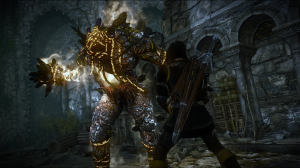 This complexity of dialogue choices makes Witcher 2 a far more interesting concept than other RPGs. I was made to pay for my decision to kill the royal progeny consistently for the rest of the prologue. Every decision has an immediate, tangible consequence, making your experience feel truly unique. The presentation of the choices meant I had to carefully consider the options, in marked contrast to Mass Effect’s style to just go for the brightly lit, Paragon Blue/Renegade Red option.
This complexity of dialogue choices makes Witcher 2 a far more interesting concept than other RPGs. I was made to pay for my decision to kill the royal progeny consistently for the rest of the prologue. Every decision has an immediate, tangible consequence, making your experience feel truly unique. The presentation of the choices meant I had to carefully consider the options, in marked contrast to Mass Effect’s style to just go for the brightly lit, Paragon Blue/Renegade Red option.
Conversation
The towns and villages are brought to life by the ambient dialogue. Soldiers engage in conversations with one another, discussing their angst about the forthcoming battle. Cooks are telling soldiers to come and get their meals while wounded men scream in agony.
All of these conversations go on as you travel the world. You can chat with every single person, but you don’t have to press a button for them to start talking. This is highlighted while Geralt is chatting to his interrogation officer and the wallows of other soldiers being tortured can be heard in the background. Their haunting cries truly add depth to the atmosphere, making you feel part of the experience.
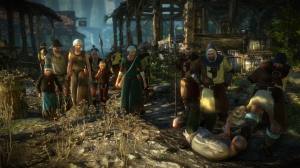 Playing through the tutorial and prologue alone took me three hours and a single playthrough can take forty hours. With playthroughs feeling so different depending on your dialogue choices, this is a game that many players will want to run through at least twice.
Playing through the tutorial and prologue alone took me three hours and a single playthrough can take forty hours. With playthroughs feeling so different depending on your dialogue choices, this is a game that many players will want to run through at least twice.
I had a blast playing The Witcher 2. The complex dialogue, the immediate consequences of your decisions, everything about it feels a step above other RPGs. There were some issues though; taking hits doesn’t feel impactful enough, meaning I died without even realising I had been hit, and the mini-map could do a better job of guiding you to the objectives. But all of the issues I had failed to slander the overall experience.
All I can say is roll on April 17th. I probably won’t be around much after that.
The Witcher 2: Assassins of Kings 2.0 is out now on PC and will be available on Xbox 360 from 17th April 2012.

One Comment